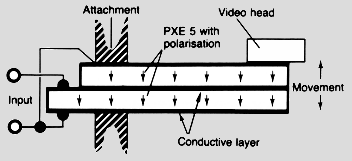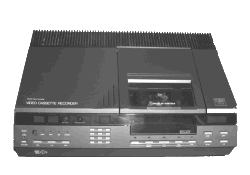Foreword
In 1983, Philips released their second-generation V2000 video recorders onto the market. These machines were, to say the least, stunning pieces of equipment. Their video record/playback performance was pretty close to that of the professional studio machines of the day. The early releases from the stable, such as the V2324, had quite a few nice features, perfect freeze-frame, frame-by-frame advance, and 7x-picture search in both directions.
The slightly later V2334 provided all of the above, and, normal-speed-reverse-play, slow motion, and 3x-picture search forward. The V2334 also came with full IR remote control.
All of these features claimed to be noise-free, and were. Considering that my year 2000 6-head VHS machine makes the same claims to being noise-free but isn't, the performance of the V2000 machines from 17 years earlier was, and still is, a truly remarkable achievement!
A Cunning Plan...
This cleverness was achieved by use of a cunning automatic tracking system called , 'Dynamic Track Following' DTF for short. The video heads were mounted on small pieces of piezo crystal that could 'bend' the heads vertical position in relation to the helical scan. Additional tones were recorded with the video signal that were detected on playback and used to generate 'steering' signals. It doesn't matter what speed you play the tape back at (within sensible limits), or which direction its travelling in, DTF corrects the helical scan angle to compensate.
Unfortunately, this cleverness may have led to the demise of V2000 before it was even launched. Problems with the implementation of the DTF system delayed the launch of V2000 and gave the other standards a chronological head start. Unfortunately, market trends seem to have dictated that the first person to grab the mass market usually wins the 'format war', irrespective of how poorly their system works. In some respects, VHS is still a technically inferior system today compared to V2000.
Several further V2000 models were released during the following 3 years. I won't bore you with the details here. Maybe they'll be covered in a further article.
If it wasn't for Philips losing the home video market to the cheaper Betamax and VHS systems, both of which were already established formats by the time of V2000's delayed arrival in 1980, their machines would have undoubtedly become the home standard. It's worth mentioning at this point that the picture quality of Betamax and VHS at this time, although poor compared to the UK broadcast standard, was adequate for the American television standard. This meant that V2000 would have been a waste of money 'st ate-side' as no one would have seen the difference anyway. Americans were buying more video recorders in the early 80's than people who lived in countries with a decent TV system like ours in the UK. This may have been an influencing factor. Who knows?
By 1986, Philips had released a Hi-Fi Stereo, Long-Play, Auto-Reverse version of the machine (I know because I nearly bought one!) but, despite the machines undeniable superiority, the 'format war' was already lost. Video libraries carrying V2000 titles were a rarity and blank tapes all but disappeared from the shops.
There were brief mutterings of a new V2000 machine at about the same time with digital stereo PCM soundtracks, but, to the best of my knowledge, it never materialised. V2000 had gasped its last dying breath.
To add insult to injury, my local V2000 stockist mysteriously burned to the ground in the same year and never re-opened. I kept my old V2334 but limited my usage of it to a few hours a month for fear of wearing out the video heads and not being able to buy replacements. Video heads on domestic machines have a typical life of only 2000 hours before wear starts to get the better of them. The machine was placed into retirement (placed under the bed to be more precise) in 1988 and only saw the light of day once a year from then on for a quick clean and polish.
In 1998, a friend at work arrived with a large cardboard box in his arms. He uttered the words, "You like these old things, don't you? Here you are mate, it's yours!". Inside was an almost immaculate Pye 23VR24 with 18 assorted tapes. His father had been through the same routine as me, but had decided to give the machine to an enthusiast (me!) rather than leaving it to rot forever.

So, I now have two machines, both in excellent working order and back out of retirement. I'm beginning to wish I'd kept my old V2020 and V2022 as well. What classics!
I've owned various VHS machines and a Betamax over the years since 1985, but none of them have come close to the performance, character, or style of any of my V2000s. They still look space-aged now!
I don't understand how a box of machinery can tug at my heartstrings the way a V2000 can. But it can, and it does. Sad aren't I ?
If you would like to bring YOUR old second-generation V2000 out of retirement, read on... Out of retirement.